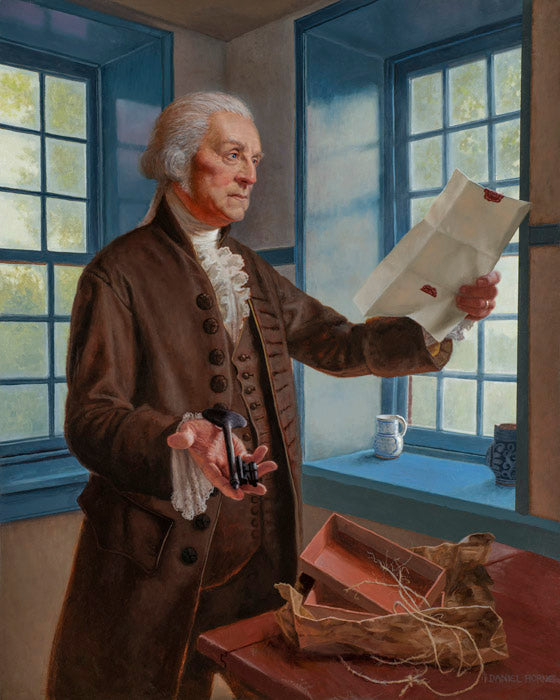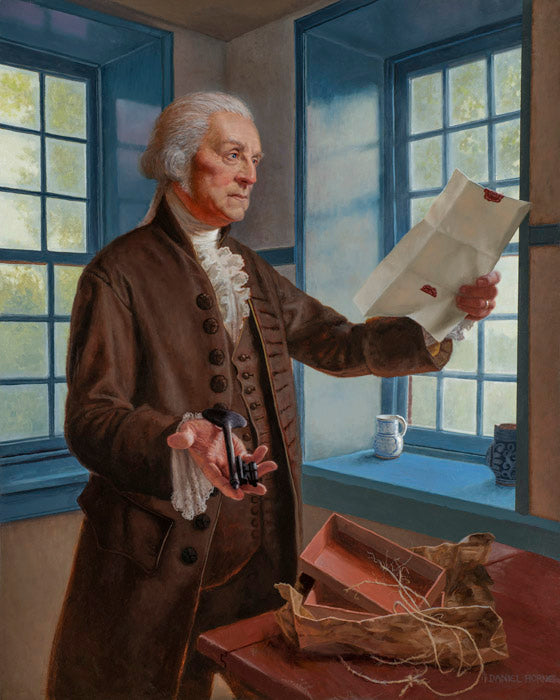Historical
Washington and the Key
Daniel Horne
In stock
Couldn't load pickup availability
Height28 inxWidth 22 in
OPEN EDITION CANVAS
Details
Details
With his military experience from serving during the American Revolution, the thirty-two year old Marquis de Lafayette quickly assumed a prominent role in the opening chapter of the French Revolution. After the Bastille fell, Lafayette was placed in command of a local national guard formed to keep order throughout France.
The Bastille main prison key was turned over to Lafayette shortly after the Bastille was stormed on July 14, 1789 by angry citizens rioting in the streets of Paris. Long a symbol of royal despotism, the Bastille was a natural target when violence erupted after severe shortages of bread led the populace into the streets. Lafayette was optimistic about the fate of the revolution when he prepared to ship the Bastille key to George Washington in March of 1790.
Several months passed before the gift finally arrived at its destination. On the first leg of the journey Lafayette entrusted the key to Thomas Paine, well-known for his participation in the American Revolution. The actual presentation to George Washington late in the summer of 1790 was an honor that fell to John Rutledge, Jr., a South Carolinian returning to the United States from London.
The principal key to the Bastille is made of wrought iron and weighs one pound, three ounces. Washington's prominent display of this celebrated souvenir in the presidential household illustrated his appreciation to his French pupil as well as recognition of its symbolic importance in America. Shown first at a presidential levee in New York in August, the key continued to be showcased in Philadelphia when the seat of government moved there in the fall of 1790.
Shortly before Washington's retirement from the presidency in 1797, the key was taken to Mount Vernon and given a place of honor in the first-floor passage. Washington's death in 1799 brought little disturbance of the Mansion's interior. However, that changed upon Martha Washington's death in 1802. With her passing, only a few original furnishings—those acquired by Bushrod Washington—were left in the mansion. The key remained in place in the mansion's passage during the next three generations of Washingtons who occupied Mount Vernon.
In 1824 a special reunion took place at Mount Vernon. The Marquis de Lafayette and his son George Washington Lafayette began a year-long tour of the United States. At Mount Vernon they found the principal key of the Bastille. For Lafayette it was a highly charged moment of sentimental reflection on past events of international significance and personal triumph.
Lafayette and his son were but two of the thousands of pilgrims who made their way annually to Mount Vernon to view the home and tomb of George Washington. This tribute was an ever-increasing burden to the Washington family who frequently accommodated their domestic comfort to visitors' schedules. In 1858, John A. Washington III, the last of the family to reside at Mount Vernon, sold the property to the Mount Vernon Ladies' Association. His gift to the Association of more than a dozen objects once owned by George Washington included the Bastille key that held such a prominent place in the mansion and amongst Washington's possessions.
Share
View full details


